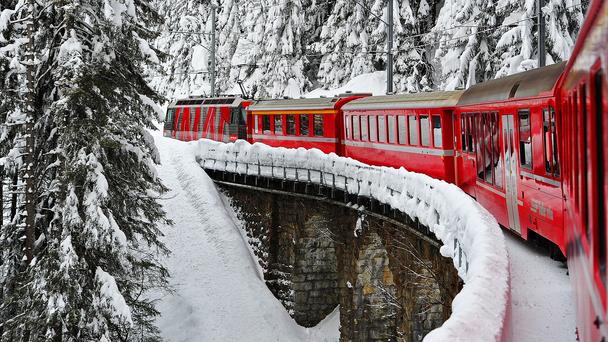Mineralbad & Spa is just one of the many alpine wonders found along the Rhäetian Railway, a scenic 240km passenger train route that runs from Thusis, Switzerland to Tirano, Italy – passing overlooked alpine villages, archaeological excavations and majestic mountain-perched castles along the way. Celebrating its 125th anniversary this year, the Rhäetian is, amazingly, not a tourist train. But it is one of only three inscribed on Unesco’s World Heritage List, featuring 84 tunnels as well as 383 spectacular bridges and stone viaducts that cross the landscape’s lacework of glittering rivers and glaciers.The first segment of the train line, a scenic two-hour, 60km stretch from Thusis to the town of Silvaplana, is short but spectacular. The track’s turns and twists provide multiple opportunities to witness the Upper Engadin’s surreal landscape, marked by cerulean waterfalls and lonely, weather-battered castles. From my seat, I counted at least five medieval castles perched high atop mountains like long-forgotten chess rooks.After the train passes the town of Tiefencastel, it leaps onto the Hope Diamond of rail design: the dramatic six-arch Landwasser Viaduct, which was built entirely of local limestone in 1901. The 65m drop to the aquamarine Landwasser River below is both terrifying and beautiful. More scarily still, the train then plunges from the viaduct into the cliff face, following a svelte black tunnel through the mountains. The whole experience lasts 45 seconds – but it’s as thrilling as any rollercoaster and could induce vertigo in the most blasé of aerialists.Exploring the Upper and Lower EngadinFor those wanting to take an overnight stop, the Upper Engadin region has hotels to suit every taste and budget. I bunked down in Silvaplana, just 5km west of St Moritz, where the Nira Alpina has direct gondola access to the 3,303m-high Corvatsh Mountain and 70 spacious rooms with balcony views of turquoise Lake Silvaplana. Its handsome head chef Marek Wildenhain even works the breakfast shift, churning out the canton’s best gipfeli (croissants), zopf (challah) and a tasty assortment of Swiss cheeses, meats, nut-spreads and homemade preserves.Take the Rhäetian’s Engadin Line to the rugged and low-key Lower Engadin, a world apart from its flashy sibling. About 46km northeast of Silvaplana, the Swiss National Park celebrates its 100th anniversary in 2014 – making it the oldest national park in the Alps. The 17,000-hectare park is remote and undeveloped, a rarity in compact and highly developed Switzerland. Its minimally groomed hiking trails remain great spots to witness alpine animals such as ibexes, chamois, marmots, northern hares and even lizards, not to mention innumerable birds and wildflowers, many of which are endangered and on IUCN’s Red List.(BBC)Bakudaily.az
The Swiss train tourists don’t take - PHOTO
World
22:00 | 24.06.2014

The Swiss train tourists don’t take - PHOTO
I floated in a steamy, 38C rooftop pool, watching glints of the sinking copper sun reflect off the Rhäetian Alps. Located in the Canton Graubünden’s town of Samedan, the public, alfresco bath at Mineralbad & Spa is nestled under the 400-year old Reformed Church clock tower, so close that the glockenspiel bells cause ripples in the water.
Follow us !










